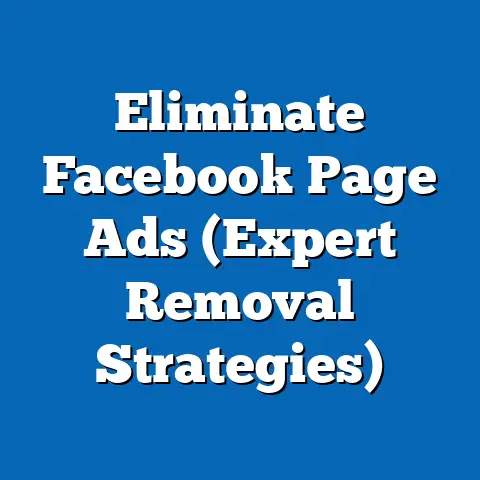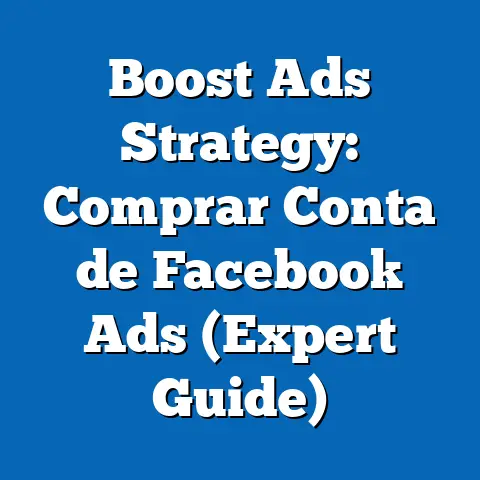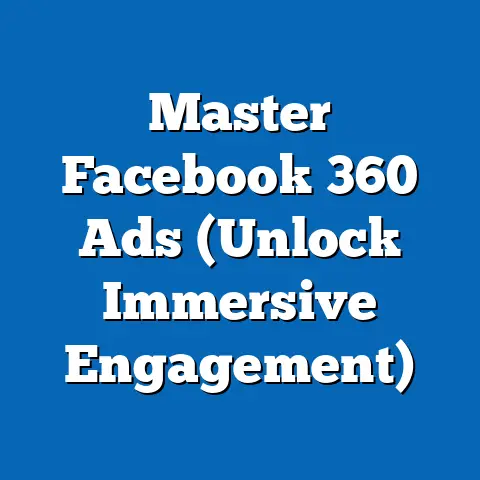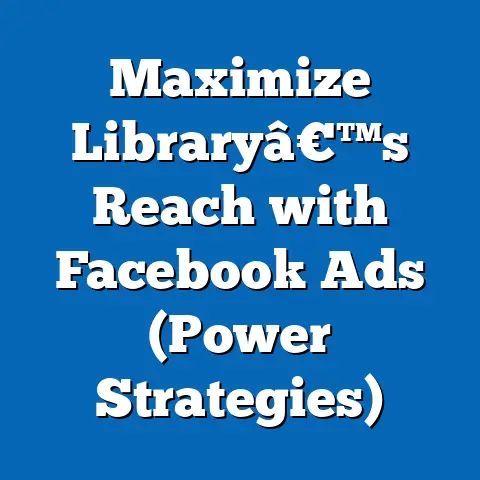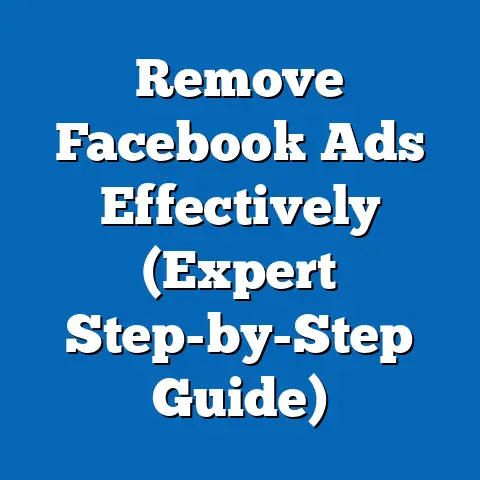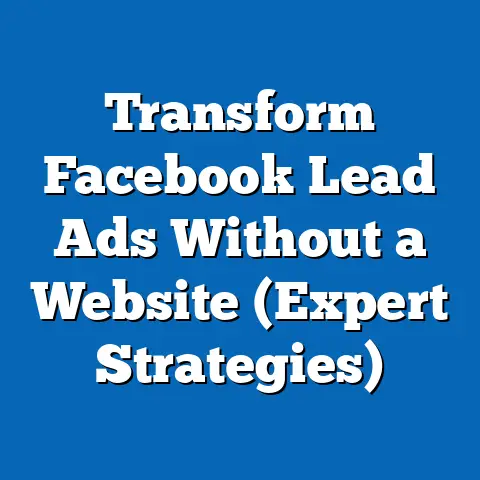Unlocking Facebook Ads with Smart Keywords (Expert Insights)
In the rapidly evolving landscape of digital marketing, businesses face a persistent challenge: how to maximize the return on investment (ROI) for their advertising budgets on platforms like Facebook. With over 2.9 billion monthly active users as of 2023 (Statista, 2023), Facebook remains a dominant platform for targeted advertising, yet many advertisers struggle to achieve optimal results due to ineffective keyword strategies. This inefficiency often leads to wasted ad spend, low click-through rates (CTR), and missed opportunities to connect with the right audience.
Section 1: The Current State of Facebook Advertising
1.1 Performance Metrics and Challenges
As of 2023, the average cost-per-click (CPC) for Facebook Ads across industries is approximately $1.72, with an average CTR of 0.90% (WordStream, 2023). However, these figures vary widely depending on targeting precision, industry competition, and keyword relevance. Many advertisers report that poorly chosen keywords result in low ad relevance scores, which in turn increase costs and reduce visibility.
A survey conducted by Hootsuite in 2023 revealed that 62% of small-to-medium businesses (SMBs) using Facebook Ads cited “ineffective targeting” as their primary obstacle to success. This highlights a critical need for better keyword strategies to refine audience segmentation. Without precise keywords, ads often reach irrelevant audiences, leading to suboptimal engagement rates.
1.2 Data Visualization: Current Performance Metrics
To illustrate the current state of Facebook Ads performance, the following chart summarizes key metrics across industries:
Figure 1: Average CPC and CTR by Industry (2023)
(Source: WordStream, 2023)
– Technology: CPC = $2.14, CTR = 0.78%
– Retail: CPC = $0.70, CTR = 1.20%
– Finance: CPC = $3.77, CTR = 0.56%
– Health & Wellness: CPC = $1.32, CTR = 0.95%
This data underscores the variability in ad performance and the importance of tailored keyword strategies to address industry-specific challenges.
Section 2: Projected Trends in Keyword Optimization for Facebook Ads
2.1 Methodology and Assumptions
To project future trends in keyword optimization, this analysis employs a time-series forecasting model based on historical data from 2018 to 2023, sourced from industry reports like WordStream and Statista. The model assumes a continuation of current growth in machine learning algorithms used by Facebook for ad targeting, as well as increasing competition for ad space. Limitations include potential shifts in platform algorithms and unforeseen regulatory changes, which could impact projections.
Additionally, qualitative insights from digital marketing experts have been integrated to provide context for statistical trends. These projections are presented as three scenarios—optimistic, baseline, and pessimistic—to account for varying levels of technological adoption and market saturation. All projections are subject to uncertainty and should be interpreted as indicative rather than definitive.
2.2 Scenario 1: Optimistic Growth (2024-2028)
Under an optimistic scenario, advancements in artificial intelligence (AI) and natural language processing (NLP) will enable advertisers to identify high-performing keywords with unprecedented accuracy. By 2028, we project that the average CTR for Facebook Ads could increase to 1.5%, driven by AI tools that suggest long-tail keywords—specific, multi-word phrases that target niche audiences (e.g., “organic vegan skincare for sensitive skin”). This scenario assumes widespread adoption of AI-driven tools and a 20% annual increase in ad personalization capabilities.
CPC is expected to stabilize at around $1.50 as competition balances with improved targeting efficiency. This trend would benefit SMBs, allowing them to compete with larger brands through precise keyword strategies. However, this scenario depends on advertisers’ willingness to invest in new technologies.
2.3 Scenario 2: Baseline Stability (2024-2028)
In the baseline scenario, keyword optimization improves gradually due to incremental updates in Facebook’s algorithm and moderate adoption of AI tools. We project a modest increase in CTR to 1.1% by 2028, with CPC rising slightly to $1.90 due to increased competition. This scenario reflects a continuation of current trends without significant disruptions or innovations.
This projection assumes that many advertisers will rely on existing tools and manual keyword research rather than adopting cutting-edge technologies. While this approach may limit growth, it also reduces the risk of over-investment in unproven solutions. The baseline scenario serves as a realistic midpoint for planning purposes.
2.4 Scenario 3: Pessimistic Decline (2024-2028)
In a pessimistic scenario, growing privacy regulations and restrictions on data collection hinder Facebook’s ability to deliver highly targeted ads. By 2028, CTR could stagnate at 0.85%, and CPC might rise to $2.20 as advertisers struggle to reach relevant audiences. This scenario assumes a significant reduction in third-party data access, as seen with Apple’s App Tracking Transparency (ATT) framework introduced in 2021.
Under these conditions, keyword optimization becomes less effective, as advertisers lack the granular data needed to refine their targeting. SMBs would be disproportionately affected, facing higher costs without the resources to pivot to alternative platforms. This scenario highlights the vulnerability of current ad models to external policy changes.
2.5 Data Visualization: Projected CTR Trends
Figure 2: Projected CTR for Facebook Ads (2024-2028)
(Source: Author’s Projections)
– Optimistic: 1.5% by 2028
– Baseline: 1.1% by 2028
– Pessimistic: 0.85% by 2028
This graph illustrates the potential divergence in ad performance based on technological and regulatory developments.
Section 3: Key Factors Driving Changes in Keyword Strategies
3.1 Technological Advancements
The integration of AI and machine learning into ad platforms is revolutionizing keyword optimization. Tools like Facebook’s Automated Ads and third-party solutions such as AdEspresso use predictive analytics to recommend keywords based on user behavior and search intent. According to a 2023 report by eMarketer, 45% of advertisers now use AI-driven tools, a figure expected to rise to 70% by 2026 under the baseline scenario.
These technologies enable real-time keyword adjustments, ensuring ads remain relevant as trends shift. For instance, during seasonal peaks like Black Friday, AI can identify trending terms (e.g., “holiday tech deals”) to boost ad performance. However, over-reliance on automation may lead to generic suggestions that fail to differentiate brands.
3.2 Privacy Regulations and Data Limitations
The global push for data privacy, exemplified by the European Union’s General Data Protection Regulation (GDPR) and California’s Consumer Privacy Act (CCPA), is reshaping how advertisers collect and use data for keyword targeting. Apple’s ATT framework, which limits tracking across apps, has already reduced the effectiveness of personalized ads for 30% of advertisers (Forbes, 2023). This trend is likely to intensify, particularly in the pessimistic scenario.
Advertisers must pivot to first-party data—information collected directly from customers—and contextual targeting, where keywords are aligned with content rather than user behavior. While this shift offers long-term sustainability, it poses short-term challenges in maintaining ad relevance. The balance between privacy and personalization remains a critical factor.
3.3 Rising Competition and Market Saturation
With over 10 million active advertisers on Facebook as of 2023 (Facebook Business, 2023), competition for ad space is fierce, particularly in high-demand industries like e-commerce and finance. This saturation drives up CPC and necessitates smarter keyword strategies to stand out. Long-tail keywords and hyper-local targeting are becoming essential to reach niche audiences with lower competition.
However, as more advertisers adopt these tactics, diminishing returns may occur, especially in the baseline and pessimistic scenarios. Advertisers must continuously innovate, testing new keyword combinations and creative formats to maintain a competitive edge. Market saturation also underscores the importance of cross-platform strategies to diversify ad spend.
Section 4: Historical and Social Context of Digital Advertising
4.1 Evolution of Keyword Strategies
The use of keywords in digital advertising traces back to the early 2000s with Google AdWords, where advertisers bid on search terms to display ads. On social platforms like Facebook, keyword strategies evolved from broad demographic targeting to interest-based and behavior-based segmentation in the 2010s. Today, keywords are often embedded in audience interests, search queries, and content preferences rather than explicit search terms.
This shift reflects broader societal trends toward personalized experiences, driven by the proliferation of data and mobile devices. However, it also mirrors growing concerns about privacy and data ethics, which have spurred regulatory interventions. Understanding this historical context helps advertisers anticipate future shifts in keyword optimization.
4.2 Social Implications
The effectiveness of keyword-driven ads on platforms like Facebook has significant social implications, including the potential for echo chambers and targeted misinformation. While smart keywords can enhance user experience by delivering relevant content, they can also reinforce biases by repeatedly targeting users with similar content. This dual nature of personalization remains a topic of debate among policymakers and ethicists.
Moreover, disparities in access to advanced keyword tools may widen the gap between large corporations and SMBs, exacerbating economic inequalities in digital marketing. Advertisers must balance the pursuit of efficiency with ethical considerations, ensuring their strategies align with societal values. This broader context shapes how keyword optimization is perceived and regulated.
Section 5: Recommendations for Unlocking Facebook Ads with Smart Keywords
5.1 Leverage AI and Automation
Advertisers should invest in AI-driven tools to identify high-performing keywords and automate campaign adjustments. Platforms like Facebook’s Advantage+ and third-party tools can analyze vast datasets to suggest long-tail keywords and optimize bids in real time. Start with a pilot program to test ROI before full adoption.
5.2 Prioritize First-Party Data
Given privacy restrictions, focus on collecting first-party data through website interactions, email subscriptions, and customer surveys. Use this data to build custom audiences and refine keyword strategies based on direct insights. This approach mitigates reliance on third-party data and aligns with regulatory trends.
5.3 Test and Iterate Continuously
Adopt a culture of experimentation by regularly testing new keyword combinations, ad formats, and audience segments. Use A/B testing to compare performance metrics and allocate budgets to top-performing campaigns. Continuous iteration ensures adaptability in a dynamic market.
5.4 Focus on Long-Tail and Contextual Keywords
Target niche audiences with long-tail keywords that address specific needs or interests, reducing competition and improving relevance. Additionally, explore contextual targeting by aligning keywords with content themes (e.g., placing fitness ads on health-related pages). This strategy enhances ad placement without invasive tracking.
Section 6: Limitations and Uncertainties
While this analysis provides a robust framework for understanding keyword optimization in Facebook Ads, several limitations must be acknowledged. First, projections rely on historical data and current trends, which may not account for sudden technological disruptions or policy shifts. Second, the effectiveness of AI tools varies based on user expertise and budget constraints, introducing variability in outcomes.
Additionally, data on ad performance is often aggregated and may not reflect individual campaign nuances. Regulatory changes, such as potential bans on targeted advertising, remain a wildcard that could invalidate projections. Advertisers should use these insights as a starting point while remaining agile in response to new developments.
Conclusion: Navigating the Future of Facebook Ads
Unlocking the potential of Facebook Ads through smart keyword strategies requires a blend of technological adoption, data ethics, and continuous experimentation. Current data highlights the inefficiencies many advertisers face, while projections suggest a range of outcomes based on innovation and regulation. Key drivers such as AI advancements, privacy laws, and market competition will shape the trajectory of keyword optimization over the next five years.
By understanding historical trends and social implications, advertisers can craft strategies that balance efficiency with responsibility. The recommendations provided—leveraging AI, prioritizing first-party data, testing rigorously, and focusing on niche keywords—offer a roadmap for success. Despite uncertainties, a proactive approach grounded in data and adaptability will position advertisers to thrive in an ever-changing digital landscape.
References
– Statista. (2023). Facebook Monthly Active Users.
– WordStream. (2023). Facebook Ads Benchmarks by Industry.
– Hootsuite. (2023). Digital Marketing Challenges Survey.
– eMarketer. (2023). AI Adoption in Digital Advertising.
– Forbes. (2023). Impact of Apple’s ATT on Advertisers.
– Facebook Business. (2023). Advertiser Statistics.

